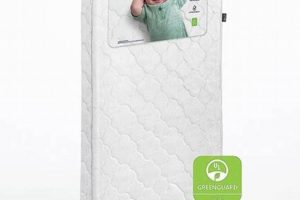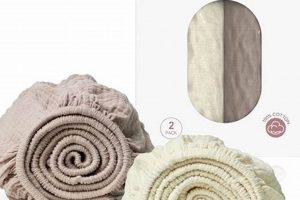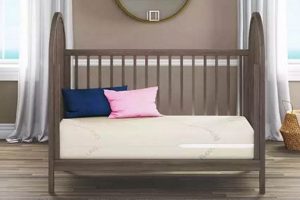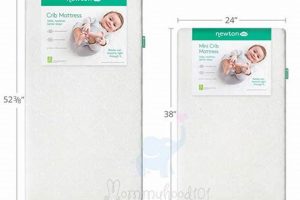A smaller sleep surface designed for infants and toddlers contrasts sharply with a larger one intended for older children and adults. The former prioritizes safety and firm support for developing bodies, typically fitting within the confines of a specialized bed frame. The latter offers more space and varying levels of comfort suitable for a growing child or single adult. For example, a family expecting a newborn will usually purchase the smaller, safer option, while parents transitioning a child to a larger bed will opt for the more expansive alternative.
Choosing the appropriate sleeping surface is crucial for ensuring proper spinal alignment and preventing potential safety hazards during early developmental stages. Historically, the development of standards for the smaller version has been driven by concerns over Sudden Infant Death Syndrome (SIDS) and the need for a firm, flat surface. The larger option, however, offers greater longevity and can accommodate the changing sleep needs of growing individuals. Investing in the correct size and firmness contributes to better sleep quality and overall well-being.
The following discussion will delve into the specific differences in dimensions, materials, safety regulations, and suitability for various age groups and developmental stages. A comprehensive comparison will clarify the optimal selection criteria based on individual needs and circumstances, highlighting key considerations for ensuring a safe and comfortable sleep environment.
Key Considerations for Selecting a Sleep Surface
Selecting an appropriate sleeping surface requires careful evaluation of several factors to ensure safety, comfort, and optimal development.
Tip 1: Verify Dimensions and Fit. Prior to purchase, confirm that the selected mattress accurately fits the intended bed frame. Gaps between the mattress and frame can pose safety risks.
Tip 2: Evaluate Firmness and Support. Infants require a firm sleeping surface to reduce the risk of suffocation. As children grow, the level of firmness can be adjusted according to their weight and preferred sleeping position.
Tip 3: Scrutinize Material Composition. Opt for mattresses constructed from non-toxic materials and free from harmful chemicals, such as phthalates and lead. Certifications from reputable organizations can provide assurance.
Tip 4: Consider Safety Standards and Regulations. Ensure that the mattress meets or exceeds current safety standards established by regulatory bodies. Compliance with these standards provides a baseline level of protection.
Tip 5: Assess Long-Term Durability. The lifespan of a mattress varies depending on its construction and materials. Investing in a higher-quality mattress can provide better support and longevity.
Tip 6: Research Waterproofing and Cleanability. Accidents are inevitable, especially with young children. Selecting a mattress with a waterproof cover or one that is easily cleaned is crucial for maintaining hygiene.
Tip 7: Understand Warranty and Return Policies. Review the warranty and return policies before making a purchase. This provides recourse in the event of defects or dissatisfaction.
Careful attention to dimensions, materials, and safety regulations is paramount for ensuring a secure and comfortable sleep environment. Selecting the appropriate option is a critical step in supporting healthy development and promoting restful sleep.
The following sections will further explore the specific advantages and disadvantages of each type of sleeping surface, offering additional guidance for making an informed decision.
1. Dimensions
The dimensional differences between these sleeping surfaces are a primary distinguishing factor and dictate their intended use. A smaller mattress is standardized to fit within the confines of a standard-sized crib, typically measuring around 28 inches wide by 52 inches long. This size is specifically designed to prevent entrapment and ensure infant safety within the crib environment. In contrast, the larger mattress adheres to dimensions suitable for a standard-sized twin bed frame, measuring approximately 39 inches wide by 75 inches long. This significantly larger surface area provides ample space for older children and single adults, accommodating their greater physical size and movement during sleep. The dimensional disparity directly reflects the differing needs of infants and older individuals.
The standardization of dimensions for each is crucial for ensuring compatibility with corresponding bed frames and adherence to safety regulations. A smaller mattress that is too small within a crib poses a significant entrapment hazard, while one that is too large will not fit properly. Similarly, a larger mattress that deviates from standard twin dimensions may not fit correctly within a twin bed frame, leading to instability and potential safety concerns. Examples of non-compliant mattresses failing to meet size requirements demonstrate the practical importance of adhering to established dimensional standards.
Therefore, understanding dimensional specifications is fundamental to selecting the appropriate sleep surface. Ignoring these differences can lead to safety hazards, discomfort, and incompatibility with intended bed frames. Dimensional considerations represent a core element in distinguishing between safe and appropriate sleep solutions for differing age groups, highlighting the need for careful measurement and adherence to established standards when selecting either a crib or twin mattress.
2. Firmness
Firmness represents a critical distinction, reflecting the differing developmental needs and safety requirements of infants and older children. The firmness of a sleep surface directly affects spinal alignment, pressure distribution, and the potential for suffocation, making it a paramount consideration in selection.
- Infant Safety and Suffocation Risk
Infant mattresses mandate a high level of firmness to reduce the risk of Sudden Infant Death Syndrome (SIDS). A firm surface prevents an infant from sinking into the mattress, minimizing the likelihood of suffocation if the infant rolls onto their stomach. For example, government regulations often specify minimum firmness levels for crib mattresses to ensure infant safety.
- Spinal Development and Support
Optimal spinal development in infants requires a flat, unyielding surface that provides consistent support. A too-soft mattress can lead to spinal misalignment and discomfort. In contrast, older children have more developed musculoskeletal systems, allowing them to benefit from slightly softer surfaces that contour to their bodies and provide pressure relief.
- Pressure Distribution and Comfort
While infant surfaces prioritize safety over comfort, mattresses for older children can offer a greater balance between support and pressure relief. Firmer models often suit stomach sleepers, while softer options may better accommodate side sleepers. Examples include memory foam or latex mattresses offering varying levels of firmness to cater to different sleep preferences.
- Material Composition and Construction
The materials used in construction directly influence firmness. Dense foam or innerspring systems contribute to a firmer feel, while softer materials like plush foam or pillow tops create a more yielding surface. A closer look at the core of the mattress reveals its lasting comfort over time.
Firmness, therefore, is not merely a matter of comfort preference but a safety imperative for infants. The transition from an infants firm, supportive surface to the more adaptable and contoured support of a twin mattress reflects the evolving needs of a growing child. Understanding these firmness-related distinctions is paramount when selecting a sleep surface appropriate for a specific age group.
3. Safety Standards
Stringent safety standards form a critical foundation in the design and manufacturing of both types of mattresses, though the specific regulations differ significantly based on the intended user and potential hazards. These standards are not arbitrary; they are developed and refined based on scientific research, incident data, and expert consensus to minimize risks and ensure infant and child well-being.
- Crib Mattress Flammability Standards
Crib mattresses are subject to rigorous flammability testing, mandated by federal regulations. These tests assess the mattress’s resistance to ignition and the speed at which a fire spreads. The standards are in place to provide crucial escape time in the event of a fire. While twin mattresses are also subject to flammability standards, the specific requirements for crib mattresses are often more stringent due to the vulnerability of infants and toddlers.
- Crib Mattress Chemical Emissions and Material Safety
Crib mattresses face heightened scrutiny regarding chemical emissions and material safety. Regulations restrict the use of certain chemicals known to be harmful to infants, such as phthalates and lead. These restrictions aim to minimize potential health risks associated with prolonged exposure to volatile organic compounds (VOCs) emitted from mattress materials. Twin mattresses, while still subject to chemical safety regulations, may not face the same level of restrictions on certain chemicals.
- Crib Mattress Construction and Design for Entrapment Prevention
Crib mattress construction and design are governed by standards aimed at preventing infant entrapment. These standards dictate precise dimensional requirements to ensure a snug fit within the crib frame, minimizing gaps that could pose a suffocation or entrapment hazard. Twin mattresses, intended for older children and adults, do not face the same stringent dimensional requirements regarding entrapment prevention.
- Crib Mattress Firmness Standards for SIDS Risk Reduction
Crib mattresses are subject to firmness standards designed to reduce the risk of Sudden Infant Death Syndrome (SIDS). A firm surface prevents infants from sinking into the mattress, minimizing the risk of airway obstruction. Twin mattresses, intended for older children with more developed musculoskeletal systems, are not subject to the same firmness standards, allowing for a wider range of firmness options to accommodate individual comfort preferences.
The differences in safety standards between crib and twin mattresses reflect the distinct developmental needs and vulnerabilities of infants and older children. Compliance with these standards is paramount for ensuring a safe sleep environment and minimizing potential health risks. It is the responsibility of manufacturers to adhere to these regulations, and consumers should prioritize mattresses that meet or exceed established safety standards.
4. Material Composition
Material composition plays a pivotal role in differentiating between crib and twin mattresses, influencing safety, comfort, durability, and regulatory compliance. The selection of materials dictates the mattress’s firmness, breathability, chemical emissions, and overall suitability for specific age groups and developmental stages.
- Foam Density and Type
Crib mattresses often utilize high-density foam to ensure firmness and prevent indentation, reducing the risk of suffocation for infants. Twin mattresses, conversely, employ a wider range of foam densities, including memory foam and latex, to cater to diverse comfort preferences. An example is the use of CertiPUR-US certified foam in both, ensuring low VOC emissions, but varying the density for appropriate support levels.
- Innerspring Coil Systems
While some crib mattresses incorporate innerspring systems for added support, twin mattresses more commonly feature intricate coil designs, such as pocketed coils, to minimize motion transfer and enhance spinal alignment. The gauge and arrangement of coils significantly impact the mattress’s firmness and responsiveness. For example, a higher coil count in a twin mattress can provide more targeted support for a growing child’s developing spine.
- Cover Fabrics and Waterproofing
Crib mattress covers prioritize waterproofing and ease of cleaning to manage spills and accidents. Materials like vinyl or polyurethane laminates are common. Twin mattress covers offer a broader range of fabrics, including cotton, bamboo, and polyester blends, often with antimicrobial treatments. The breathability and hypoallergenic properties of these fabrics are important considerations for older children and adults.
- Flame Retardant Barriers
Federal regulations mandate flame retardant barriers in both crib and twin mattresses to mitigate fire hazards. However, the materials used for these barriers can vary. Crib mattresses often utilize inherently flame-resistant materials like silica or wool, while twin mattresses may incorporate chemical flame retardants, subject to regulatory scrutiny. The choice of flame retardant material directly impacts the mattress’s chemical profile and potential health effects.
The material composition of crib and twin mattresses reflects a balance between safety imperatives, comfort considerations, and regulatory requirements. The deliberate selection of specific materials underscores the distinct design priorities for each type of sleeping surface, emphasizing the importance of informed decision-making based on age, developmental stage, and individual needs.
5. Intended Age
The suitability of a sleep surface is inextricably linked to the age of the individual for whom it is intended. The physical and developmental needs of an infant differ drastically from those of a toddler or older child, necessitating distinct mattress designs and safety features. Considering the age range for which each mattress type is designed is paramount for ensuring safe and healthy sleep.
- Infant (0-12 Months)
Crib mattresses are specifically designed for infants within this age range. The primary concerns are safety and proper spinal support. Firmness standards are high to reduce the risk of SIDS, and dimensions are regulated to prevent entrapment within the crib frame. Material composition prioritizes non-toxic materials to minimize exposure to harmful chemicals. For example, a newborn’s developing spine requires the unyielding support of a firm crib mattress.
- Toddler (1-3 Years)
While some toddlers may continue to use a crib mattress within a toddler bed conversion, this age group often represents a transition period. Parents may consider transitioning to a twin mattress as the child outgrows the crib or demonstrates the ability to safely navigate a larger sleeping surface. However, safety features such as bed rails and low bed frames become crucial considerations during this transition. Consider a toddler who has reached the height or weight limit for a crib, signaling the need for a larger bed.
- Child (3+ Years)
Twin mattresses are generally recommended for children aged three and older. By this age, children have developed greater motor skills and coordination, reducing the risk of falling out of bed. Twin mattresses offer ample space for growth and movement during sleep. Furthermore, the increased availability of material and firmness options allows for greater personalization based on individual preferences. For instance, a child who enjoys reading in bed might prefer a slightly softer mattress with enhanced edge support.
- Adolescent/Adult
While a twin mattress can continue to serve an individual through adolescence and adulthood, larger sizes such as full, queen, or king may offer greater comfort and space, particularly for taller individuals or those who share a bed. The choice of mattress size and type ultimately depends on individual preferences, budget considerations, and available space. A growing teenager may appreciate the additional legroom afforded by a larger mattress size.
The age-appropriateness of a sleep surface is not merely a matter of convenience but a critical factor in ensuring safety, promoting healthy development, and maximizing sleep quality. The distinct characteristics of crib and twin mattresses, including firmness, size, and material composition, are tailored to meet the unique needs of different age groups. Therefore, careful consideration of intended age is essential when selecting the most suitable sleep surface.
6. Support Needs
Support needs constitute a critical differentiating factor between crib and twin mattresses, driven by the distinct physiological characteristics and developmental stages of their intended users. Infant support needs center on providing a firm, unyielding surface to mitigate the risk of Sudden Infant Death Syndrome (SIDS) and promote proper spinal development. A firm surface prevents the infant from sinking into the mattress, reducing the potential for airway obstruction. Conversely, older children and adults using twin mattresses require more adaptable support, allowing for spinal alignment and pressure relief. The shift from a rigid surface to one that contours to the body reflects the development of the musculoskeletal system and the varying sleep positions adopted as individuals grow.
Consider the consequences of mismatching support needs. Placing an infant on a twin mattress with a plush pillow top could increase the risk of suffocation due to the infant’s inability to reposition themselves on a yielding surface. Conversely, an older child sleeping on a too-firm crib mattress might experience discomfort and disrupted sleep due to inadequate pressure distribution. The practical significance of understanding these support differences lies in ensuring the safety and well-being of individuals at different developmental stages. Proper support contributes to healthy spinal alignment, reduces the risk of injury, and promotes restful sleep.
In summary, support needs dictate the core design and material choices in crib and twin mattresses. A crib mattress prioritizes safety and firm support for developing infants, while a twin mattress offers more adaptable support for older children and adults. Recognizing the cause-and-effect relationship between mattress support and physical health is essential for making informed decisions and creating a sleep environment conducive to healthy development and restorative rest. Failure to address these differences can negatively affect sleep quality, physical well-being, and overall health outcomes.
7. Lifespan
The lifespan of a mattress is a crucial consideration, varying significantly between the smaller and larger sleep surfaces due to differences in construction, intended use, and regulatory standards. This longevity directly impacts the cost-effectiveness and sustainability of the purchase.
- Usage Intensity and Weight Capacity
Crib mattresses are designed for limited usage, typically lasting from infancy to toddlerhood (approximately 0-3 years), reflecting a lower weight capacity and less intensive daily use. In contrast, twin mattresses are intended for older children, adolescents, and even adults, enduring higher weight loads and prolonged daily usage, potentially lasting for 7-10 years or longer. For example, a crib mattress may experience only a few hours of use each day, while a twin mattress is subjected to continuous use throughout the night.
- Material Degradation and Support Integrity
Over time, mattress materials degrade, leading to diminished support and comfort. Crib mattresses, due to their denser construction and focus on firmness, may exhibit slower degradation compared to twin mattresses with softer comfort layers. However, both types are susceptible to wear and tear, including foam compression, coil fatigue (in innerspring models), and fabric breakdown. The longevity of each depends on the quality of materials used and the adherence to recommended care guidelines.
- Hygiene and Sanitation Concerns
Maintaining hygiene and sanitation is essential for extending the lifespan of any mattress. Crib mattresses are particularly vulnerable to spills and accidents from infants and toddlers, necessitating waterproof covers and frequent cleaning. Twin mattresses, while less prone to such incidents, can accumulate dust mites, allergens, and body fluids over time. Regular vacuuming, professional cleaning, and the use of mattress protectors are crucial for maintaining a hygienic sleep environment and prolonging the mattress’s lifespan.
- Safety Standard Compliance and Regulatory Updates
Safety standards and regulations governing mattress construction and materials evolve over time. A mattress that meets current safety standards at the time of purchase may become non-compliant as regulations are updated. This is particularly relevant for crib mattresses, where standards regarding flammability, chemical emissions, and entrapment hazards are subject to ongoing review and revision. Consumers should be aware of these updates and consider replacing older mattresses that no longer meet current safety requirements, regardless of their apparent condition.
The lifespan of a sleeping surface is influenced by numerous factors, and it is only one aspect of the many facets that make up the differences between them. In the context of “crib mattress vs twin mattress,” understanding these lifespan considerations is crucial for making informed purchasing decisions that balance cost-effectiveness, sustainability, and adherence to evolving safety standards. Careful selection, proper maintenance, and timely replacement are essential for ensuring a safe, comfortable, and hygienic sleep environment throughout the mattress’s usable life.
Frequently Asked Questions
This section addresses common inquiries and misconceptions regarding the differences between these two types of sleeping surfaces, providing clear and concise answers based on expert knowledge and established guidelines.
Question 1: What are the primary safety concerns associated with using a twin mattress for an infant?
The primary safety concern is the increased risk of suffocation. Twin mattresses are typically softer than crib mattresses, potentially allowing an infant to sink into the surface and obstruct their airways. Additionally, the larger size of a twin mattress compared to a crib can increase the risk of entrapment.
Question 2: Is it acceptable to place a crib mattress on a twin bed frame?
No. A crib mattress is not designed to fit a twin bed frame. Significant gaps will exist between the mattress and the frame, creating a dangerous entrapment hazard. A crib mattress must be used with a crib or toddler bed specifically designed to accommodate its dimensions.
Question 3: How do the flammability standards differ between these mattresses?
While both are subject to flammability standards, crib mattresses often face more stringent requirements due to the increased vulnerability of infants. This may involve stricter testing protocols and limitations on certain flame-retardant chemicals.
Question 4: What is the recommended firmness level for a crib mattress to minimize the risk of SIDS?
A crib mattress should be sufficiently firm to prevent an infant from sinking into the surface. Specific firmness guidelines are often outlined by regulatory bodies and pediatric health organizations. Consulting these guidelines is crucial when selecting a crib mattress.
Question 5: Can a used mattress be safely repurposed for a crib or a twin bed?
Repurposing a used mattress is generally discouraged, especially for cribs. Used mattresses may harbor allergens, bacteria, and mold, posing potential health risks. Additionally, the structural integrity of a used mattress may be compromised, affecting its support and safety. When selecting any kind of mattress you have to be certain that the components are safe to use. It is better to be safe than sorry.
Question 6: What are the key factors to consider when transitioning a child from a crib to a twin bed?
Key factors include the child’s physical development, ability to safely navigate a larger bed, and the implementation of appropriate safety measures, such as bed rails. The child should also be psychologically ready for the transition, demonstrating a desire for greater independence.
In summary, the selection of an appropriate sleeping surface necessitates careful consideration of safety standards, intended age, and individual support needs. Ignoring these factors can have significant consequences for a child’s health and well-being.
The following section provides a concise summary of the key differences discussed throughout this article, reinforcing the importance of making informed decisions when selecting a mattress for your child.
Conclusion
This exploration has illuminated critical distinctions between a smaller sleeping surface designed for infants and a larger one intended for older children and adults. Dimensions, firmness, safety standards, material composition, intended age, support needs, and lifespan each contribute to the suitability of either option for distinct developmental stages. The divergence in these factors underscores the importance of selecting a sleep surface that aligns with the specific needs and vulnerabilities of its intended user.
The informed application of this knowledge is essential for ensuring a safe and supportive sleep environment, fostering healthy development, and promoting overall well-being. Prioritizing safety standards, age-appropriateness, and individual support requirements remains paramount. Continued vigilance and adherence to expert guidelines are vital for navigating the complexities of selecting an appropriate mattress, ultimately contributing to improved health outcomes and enhanced quality of life.







